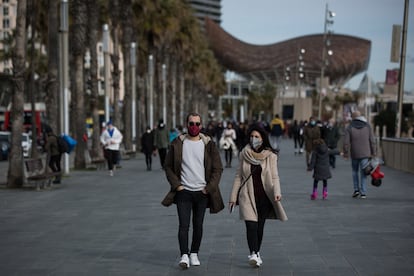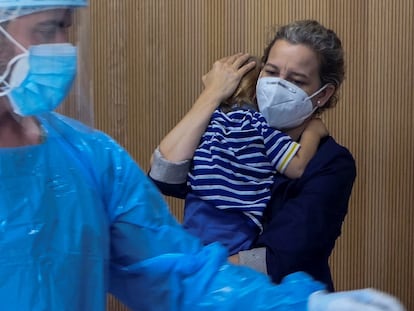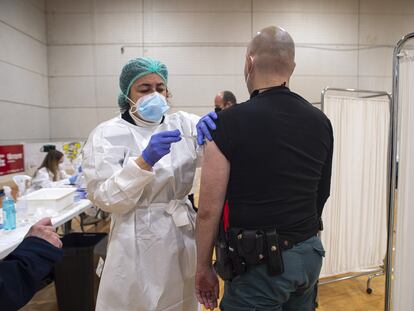Coronavirus deaths in Spain fall to lowest level since October, but experts warn of fourth wave
The Health Ministry reported 4,962 new cases and added 141 fatalities to the official toll on Tuesday as concerns grow of a future spike in infections

The Health Ministry’s latest coronavirus report, released on Tuesday, reflects an ongoing downward trend, albeit one that is now very weak. The clearest example of this is in the 14-day cumulative number of coronavirus cases per 100,000 inhabitants, which fell just 1.17 points yesterday to 127.8. The curve for this key indicator is practically flat. What’s more, if the figures are looked at region by region, the rate has actually risen in a majority of territories from the previous day. This is the case in Andalusia, the Balearics and Canary Islands, Cantabria, Castilla-La Mancha, Extremadura, Galicia, Murcia, Navarre and the Basque Country, as well as in the North African exclave city of Melilla.
The number of new infections reported on Tuesday was 4,692, which is the second-lowest daily figure since last summer. The total number of official coronavirus infections in Spain now stands at 3,200,024 since the pandemic began. The number of cases over seven days is currently 35,041, very close to the 35,000 registered the week before.
The number of Covid-19 fatalities also continues to fall. On Tuesday, the country’s regions reported 141 deaths after a positive coronavirus test, the lowest daily figure since October 15 of last year. The seven-day figure is of particular note, coming in at 838 – half the figure seen a week ago. In total, since the pandemic began, the Health Ministry has recorded 72,565 official Covid-19 deaths.
As for the pressure on hospitals, 7.54% of regular beds are currently occupied by coronavirus patients, while in the country’s intensive care units (ICUs), the rate has dropped from 23.24% a week ago to 20.24% in Tuesday’s report.
A fourth wave?
Given the situation, the question that concerns experts is whether the country is facing a fourth wave of the health crisis, or if there is a chance to avoid that situation. In a pandemic with so many scientific factors (new variants of the virus, vaccines), political factors (curfews, perimetral lockdowns, capacity limits) and personal factors (the use of masks, social distancing, limits on social meetings), there is a range of opinions. However, the majority consider such a new spike to be very likely.
Rosario López, the research director at the Foundation for Health Research, says that it is normal for a curve to descend slower when it reaches low levels, adding that “it should continue to fall if [coronavirus restrictions] are kept in place.” But she insists that there is uncertainty: it is difficult to make predictions with values that depend on so many factors. She insists that the measures must not be lifted for the incidence to continue falling. She also points out that existing models do not include the impact of Covid-19 vaccines, which she believes will be decisive.
The specialist is trying to remain optimistic, but Joan Caylà, the president of the Spanish Epidemiological Society, believes that “everything is pointing to a quite high probability that [the incidence of the virus] is going to rise.” The doctor points out that, according to data from the European Center for Disease Prevention and Control, this is already happening in two of the five biggest countries in Europe: Italy and France. “And the latter country is right next door to us,” he says. In Germany, there is also an uptick and only the United Kingdom and Spain are seeing continued falls. “In Italy, they are closing things down right now and here we are doing the opposite,” he points out.
The reduction in the incidence can be expected to be very small when the value approaches zero, explains Rafael Ortí, the president of the Spanish Society of Preventive Medicine, Public Health and Hygiene. But this flattening of the curve is happening in Spain while the indicator is still above 120 – the current restrictions in place are not enough to push it down further, he adds. Ortí believes that because of this there will be a fourth wave. The expert says that regions such as Valencia, where the indicator is below 50 right now, will notice it much less than a place like Madrid, for example, where the 14-day cumulative number of coronavirus cases per 100,000 inhabitants is still above 200.
Meanwhile, Manuel Franco, the spokesperson for the Spanish Society of Public Health and Health Administration, remains optimistic. Franco insists on the fact that the figures are continuing to fall. “The problem is the [lack of] availability of the vaccines,” he says. “It’s a shame.” However, the PreCov2 program, which has been developed by Spain’s UNED distance-learning university, calculates that from next week the incidence will start to rise. During a videoconference meeting organized by the Spanish Society of Community Pharmacy, Santiago Moreno, a doctor specializing in infectious diseases, said that “if we don’t apply what we have learned, the fourth wave will be inevitable.”
English version by Simon Hunter.
Tu suscripción se está usando en otro dispositivo
¿Quieres añadir otro usuario a tu suscripción?
Si continúas leyendo en este dispositivo, no se podrá leer en el otro.
FlechaTu suscripción se está usando en otro dispositivo y solo puedes acceder a EL PAÍS desde un dispositivo a la vez.
Si quieres compartir tu cuenta, cambia tu suscripción a la modalidad Premium, así podrás añadir otro usuario. Cada uno accederá con su propia cuenta de email, lo que os permitirá personalizar vuestra experiencia en EL PAÍS.
¿Tienes una suscripción de empresa? Accede aquí para contratar más cuentas.
En el caso de no saber quién está usando tu cuenta, te recomendamos cambiar tu contraseña aquí.
Si decides continuar compartiendo tu cuenta, este mensaje se mostrará en tu dispositivo y en el de la otra persona que está usando tu cuenta de forma indefinida, afectando a tu experiencia de lectura. Puedes consultar aquí los términos y condiciones de la suscripción digital.
More information
Últimas noticias
David Bowie, the galactic thinker who encouraged us to break new ground
John Berger and the loss of rural culture
From police officer to bloodthirsty kidnapper: Terror in Mexico during the years of ‘The Ear Chopper’
Alain Aspect, Nobel laureate in physics: ‘Einstein was so smart that he would have had to recognize quantum entanglement’
Most viewed
- David King, chemist: ‘There are scientists studying how to cool the planet; nobody should stop these experiments from happening’
- Reinhard Genzel, Nobel laureate in physics: ‘One-minute videos will never give you the truth’
- Oona Chaplin: ‘I told James Cameron that I was living in a treehouse and starting a permaculture project with a friend’
- Mexico completes its trade shift with the entry into force of tariffs on China and countries without trade agreements
- Sinaloa Cartel war is taking its toll on Los Chapitos










































